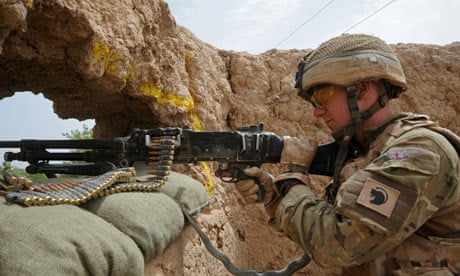Acute care for the troops most seriously injured in Afghanistan is costing the government more than £500,000 every week, figures suggest.
The military wards at the Birmingham NHS foundation trust receive over £2m every month from the Ministry of Defence to care for the dozens of troops who need the most specialised trauma care.
The cost of repatriating then treating injured soldiers and other personnel at Selly Oak hospital between May and July this year – then at Birmingham's Queen Elizabeth hospital after the military wards were transferred to the new hospital up until the end of September – was £10.25m, figures in government spending data released last week show. The receipts included a large spike in August, when the MoD paid the trust nearly £5m.
Separate government figures reveal that over the same period, there were 83 military service personnel who sustained serious or very serious injuries in combat in Afghanistan. The vast majority would have been transferred to the UK for treatment at the Birmingham hospital. Those with the most complex brain and spinal injuries, and those who have lost limbs, are sometimes then transferred to the MoD-run Headley Court in Surrey for longer-term rehabilitation.
The spending figures, published by the government last week to bring greater transparency to government, contain no figures on the costs of Headley Court, which is funded internally by the MoD.
A spokesman for the Royal British Legion said: "Battlefield medicine is excellent, Selly Oak is excellent, Headley Court is excellent. The gap has been in the aftercare, and particularly in the transition period when personnel are in the rehabilitation stage and it's not clear whether they will be going back into service again."
A number of charities are stepping in to set up personnel recovery capability centres, which will be based within garrisons, where people recovering from serious injury will be given physical and emotional support while it is decided whether they will go back into service, or return to civilian life, he added.
An MoD spokesman said: "You cannot put a price on the importance of caring for our injured servicemen and women, they deserve the very best. The new military ward at Queen Elizabeth hospital in Birmingham provides the highest quality clinical care and gives our medical staff the broadest and most up-to-date training and experience. It brings together the highest standards of clinical excellence with military support, not just for the casualties but also for their families."
Headley Court has been forced to triple its capacity since 2007 to cope with new admissions with serious injuries sustained in Afghanistan. In February this year, the National Audit Office warned that hospitals treating the wounded from Afghanistan, principally Selly Oak, were close to capacity. The move to Queen Elizabeth's has relieved that pressure, an MoD spokesman said.
The figures on care costs for injured troops were identified by a Guardian website reader using a database created by Guardian developers last week. It prompted a stream of reports from readers on previously unknown figures, such as the Selly Oak costs.
Other reports included a £95,000 bill for flag-flying, and £150,000 for "confidence classes" for diplomats at the acting school Rada. another reader emailed to point out the £1.5m monthly bill for Teachers TV, which was cancelled in July and now exists only online.
